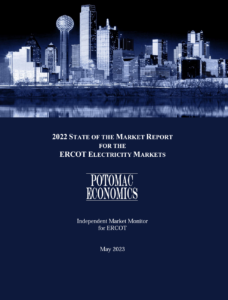The IMM concludes that there should exist sufficient revenues in the energy and Ancillary Services market to maintain ERCOT’s existing generation fleet and to support investment in new resources.
________________________________________________
Each spring the Independent Market Monitor for ERCOT (“IMM”) releases a State of the Market report, as required by law. These annual reports identify perceived flaws in ERCOT market design, provide recommendations for market reforms, and include reams of otherwise useful data. The IMM released its latest report, which covers the ERCOT market during 2022, late in May.
Below we summarize this latest report. The full report can be found online at the Potomac Economics website, www.potomaceconomics.com.

The IMM’s most recent State of the Market report characterizes 2022 as marked by both market growth and elevated prices.
Overview
The IMM’s most recent State of the Market report characterizes 2022 as marked by both market growth and elevated prices. Although not reaching the Winter Storm Uri-distorted levels of 2021, average prices for energy and for natural gas in 2022 were still generally three times as high as prices recorded during the year immediately prior to Uri, according to the report.
Then-PUC Chair Peter Lake announced after Uri that ERCOT would begin pursuing a “conservative” operating approach under which various measures intended to increase wholesale power prices would have earlier trigger points — that is, they would take effect before power supplies became overly tight. The effects of this conservative approach can be seen throughout the IMM’s report, with higher costs for Ancillary Services as well as from an amended price adder system administered by ERCOT known as the Operating Reserve Demand Curve, or “ORDC.”
Given the high prices, the IMM concludes that there should exist sufficient revenues in the energy and Ancillary Services market to maintain ERCOT’s existing generation fleet and to support sufficient investment in new resources. However, the IMM also found that net market revenue has decoupled from the forecasted planning reserve margin because of price distortions introduced by the ORDC.
Key Observations
Competition and Market Power: The ERCOT market generally performed competitively in 2022, with some notable exceptions.
- Larger procurements of an Ancillary Service known as “non-spin reserve service” led to higher prices for the service, including a nearly $100 million increase during the second half of 2022. These larger procurements occurred because of ERCOT’s more conservative operating posture.
- Insufficient incentives to self-commit resources in the day-ahead market led ERCOT to overly rely upon Reliability Unit Commitment (“RUC”) instructions to generators, according to the IMM. (Generators that come under RUC instructions must provide additional capacity to the ERCOT system in exchange for formula-based compensation).
Demand and Supply: ERCOT generally reported higher capacity and peak load during 2022.
- The summer peak of 80,038 megawatts (MW) exceeded the 2021 peak by 8.8 percent.
- Average load grew by 9.5 percent over 2021, with the largest load growth in the West Zone (18.9 percent) and the South Zone (11.9 percent).
- Renewable capacity expanded by 7,000 MW of wind and solar, plus 1,700 MW of energy storage.
- Natural gas capacity expanded by a net of 280 MW (700 MW new turbines less 420 MW retired).
- The IMM believes that the projected retirement rate of thermal units reported by ERCOT in its most recent Capacity, Demand and Reserves report is overstated.
Energy Market Prices: Energy prices generally were higher than pre-Winter Storm Uri levels.
- The value of energy in 2022 totaled $32.2 billion.
- Real-time prices averaged $75 per megawatt/hour — nearly triple the pre-Winter Storm Uri average price in 2020.
- Gas prices averaged nearly $6 per MMBtu in 2022, well up from the pre-Uri price at $2 per MMBtu.
- Modifications to the ORDC ordered by the PUC following Winter Storm Uri raised energy prices by $1.7 billion in 2022, doubling the ORDC impact on prices. The largest share of ORDC revenues flows to thermal resources.
Recommendations
The IMM offered more than a dozen recommendations for market reform. Due to their highly technical nature, we do not enumerate all of them here. Some recommendations include the following:
- The IMM continues advocating for Real-time Co-optimization as the “most important improvement to the ERCOT market over the long term.” With Real-Time Co-Optimization, ERCOT would merge management of the otherwise separate Real-Time and Ancillary Services markets with the goal of more efficiently deploying lower-cost energy on a real-time basis.
- The IMM calls for clawing back 100 percent of excess market revenues for units under RUC orders. This change would help eliminate any incentives for generators to not self-commit resources.
- Under the PUC’s existing Small Fish Rule, generation entities with relatively small market share can take actions that otherwise would be considered an abuse of market power if undertaken by a larger entity. The IMM calls for the elimination of this rule.
- The IMM calls for creating and implementing a new Ancillary Service known as the “Uncertainty Product.” Recently enacted HB 1500 also calls for the implementation of this Ancillary Service, which is intended to shore up system reliability during times of uncertain grid conditions.
- In contrast to the four highly aggregated load zones currently overseen by ERCOT, smaller load zones should be created to recognize key transmission constraints, according to the IMM.

